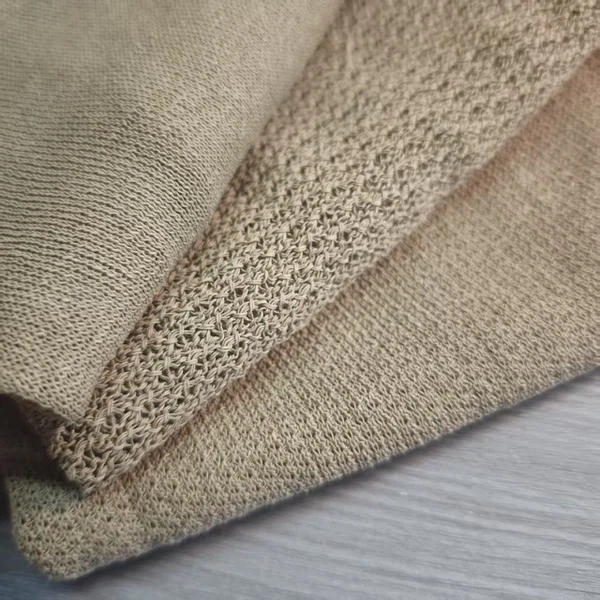In the "environmental laboratory" of the textile industry, 100% paper knitted fabrics are redefining "sustainable fashion" with a disruptive attitude - it not only retains the natural genes of paper, but also breaks through the limitations of traditional paper products through modern textile technology, becoming one of the most talked-about green materials at present.
1. Advantages and disadvantages of paper knitted fabrics: balanced aesthetics in contradictions
As "breathing paper", its advantages come with natural attributes:
✅ Environmental protection genes: using renewable plant fibers such as wood pulp and bamboo pulp as raw materials, it can be completely biodegraded after being discarded, and the whole process from planting to recycling is low-carbon;
✅ Unique texture: The surface presents the delicate texture unique to paper, and the matte soft focus feeling is different from the "plastic feeling" of chemical fiber fabrics, and it has a high-end atmosphere;
✅ Functional surprise: crisp and stylish, and better breathability than cotton and linen (fiber gaps are more uniform).
Of course, it also has its "little temper":
❌ Wet strength is weak: it will soften temporarily when in contact with water (similar to paper towels in contact with water), but it can recover 80% of its strength after drying;
❌ Color fastness needs to be customized: natural fibers have weak adsorption to dyes, and plant dyeing or low-temperature color fixing technology is required. Colored yarn is woven into fabrics, which is slightly more expensive but healthier;
❌ High cost: from pulp modification to knitting technology, the technical threshold is higher than that of ordinary chemical fibers, and it is currently positioned in the mid-to-high-end market.
2. From "paper clothes" to "paper spinning": the fashion evolution history of paper fibers for thousands of years
The fate of paper and textiles can be traced back to the "paper clothes" in the 3rd century AD-after the ancient Chinese made paper from paper bark, they tried to paste multiple layers of paper into clothes for warmth. However, due to the limitations of technology, the "paper clothes" at that time were hard, brittle and easy to break, and were only used in special scenes.
In the 20th century, the technological breakthrough of Japanese "washi" laid the groundwork for paper fiber textiles: by adding natural adhesives, the strength of washi paper was improved and it began to be used for kimono lining. It was not until the 21st century that the German Textile Laboratory developed the "pulp fiber spinning technology", which dissolved wood pulp into spinning liquid, and then formed continuous filaments through spinning and stretching - so far, 100% paper fiber finally has the "spinnability" of knitting.
In recent years, with the awakening of environmental awareness, paper knitted fabrics have ushered in an explosive period: from the paper fiber dresses at Milan Fashion Week to MUJI's MUJI-style paper spinning home series, it is becoming a new favorite of sustainable consumption with the dual labels of "natural degradation + fashion expression".
3. The "Survival Law" of Paper Knitting: It is best at these scenes
The charm of paper knitting lies in "using the weakness of nature to achieve the highlights of design":
Fashion wear: suitable for occasions that require "presence but not exaggeration" - a thin paper-spun shirt paired with a suit is breathable and not stuffy; a crisp paper knitted dress has a drape comparable to silk, but comes with a "degradable" environmental protection story;
Home furnishings: tablecloths, placemats, pillowcases, the natural paper texture adds a "wabi-sabi" ritual sense to the dining table, and can be wiped wet when dirty (mild stains do not penetrate);
Environmental marketing: temporary decorations of brand pop-up stores and "take-away packaging" of exhibition brochures, which are disposable and burden-free, but strengthen brand responsibility.
----
Paper is a gift from nature; knitting is mankind's obsession with beauty. When the two meet, what we see is not only the innovation of materials, but also the awakening of a life attitude - fashion does not have to sacrifice the environment, and beauty should coexist with nature.
Experience it now and make every wear a gentle response to the earth.


